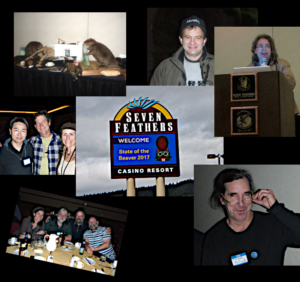We are just three weeks away from the conference that started it all. The state of the beaver (November 13-15) was the proto type and the inspiration for the Maryland conference, the beaver institute and so much more. It’s where I met Sherri Tippie, Mary Obrien, Glynis Hood, Derek Gow, Paul and Louise Ramsay,Mike Callahan, Kent Woodruff. Suzanne Fouty. and so many other beaver founding fathers and mothers. If there is any single way you can get yourself there you should try. It’s that good.
The Beaver State of Mind
A rural town in Oregon became an unlikely epicenter of global efforts to restore the semi-aquatic rodent. Starting in mid-November, the State of Beaver Conference will host beaver experts and conservationists from all over the world.
 Oregon’s state flag features a beaver on its back side in honor of the state’s nickname, “The Beaver State” – a moniker it earned when trapping beavers for the early nineteenth-century fur trade played a large role in the exploration and settlement of a territory that became a state in 1859.
Oregon’s state flag features a beaver on its back side in honor of the state’s nickname, “The Beaver State” – a moniker it earned when trapping beavers for the early nineteenth-century fur trade played a large role in the exploration and settlement of a territory that became a state in 1859.
So, it is appropriate that Canyonville, Oregon, a small town with a population of 1,660 located in the Klamath Mountains of Southern Oregon is the global locus of efforts to restore beavers throughout their traditional range in the wild. The 2023 State of the Beaver conference (November 13-15, 2023) will draw up to 300 beaver restoration advocates and re-wilding movement activists from all over North America and Europe.
Interest in beavers has been steadily increasing over the past thirteen years due to the low-cost and extensive benefits to the environment and wildlife that they bring when planted in streams. Water storage, in these times of increasingly frequent drought, is one obvious boon to farmers, ranchers as well as rural towns and cities.
That beaver-dam water also helps restore anadromous fish runs. It provides homes for waterfowl and aquatic creatures such as frogs and salamanders as well as drinking water for other wild creatures. Beavers are remarkably efficient in this.
What a wonderful beginning. Lois and Leonard Houston are the nicest hosts you could ever hope to meet and by the end of three days taking care of every persons needs so profoundly, Lois is often exhausted and hanging on by a thread. But they have kept it up, year after year. And the effect is measurable across two continents.
 According to Stanley Petrowski, one of the founders of the conference, “Seventy-five percent of the artificial wetland restoration projects done in America over the past thirty years have failed but when beavers do it, they do it perfectly.”
According to Stanley Petrowski, one of the founders of the conference, “Seventy-five percent of the artificial wetland restoration projects done in America over the past thirty years have failed but when beavers do it, they do it perfectly.”
The conference is an annual event that began in 2010 after two local neighbors, Stanley Petrowski and former logger Leonard Houston attended a government agency working group meeting in which representatives of state and federal scientists were at odds about efforts to restore beavers with the timber and agricultural faction in opposition to the fisheries and wildlife crowd.
“We were really disappointed by all the wrangling and decided to host our own get-together to try to get past that,” Petrowski said in an interview for this story.
With the support of the South Umpqua Rural Community Partnership through grants obtained for the purpose and the help of the Cow Creek Band of Umpqua Tribe of Indians, who supplied the use of Seven Feathers Casino and Resort, SURCP was able to bring together about 150 scientists and restoration advocates from all over North America and Europe for a three-day conference.
The Cow Creek Tribe offers up the Casino conference room and starts the event off with a traditional blessing. There generosity makes the conference possible and Stan Petrowski dogged technology and emcee efforts keep it moving. I missed the first one that Skip Lisle attended, but I didn’t that make that mistake again.
That first conference brought together people from agencies and scientific disciplines who had never met but who discovered there that they had a common interest in beaver ecology. This year’s event is also being sponsored by the National Oceanic and Atmospheric Administration (NOAA), the Maine Community Foundation, and seven other organizations dedicated to beaver restoration.
It may seem odd that European visitors are among the participants but restoration efforts for the Eurasian Beaver, a close cousin to the North American Beaver that Canadians and Americans are familiar with, is a growing field in several nations such as Britain, Norway, Belgium, Germany, Lithuania and Poland with some of their efforts underway at scales that are often ahead of those here in the New World.
Hosting the conference has brought an economic boon to both the tribe and the small town as well. The arrival of hundreds of scientists, activists, and lecturers who spend both their time and their dimes in the community is a significant help to the small town. Lodging at the casino and local motels for the event by itself brings in tens of thousands of dollars from outside the area.
In addition to the presentations by ecologists, wildlife and fisheries biologists, and activists this year’s conference will feature a panel of representatives from eight East Coast indigenous tribes who will speak of the role of beavers in their culture both traditionally and about their current restoration efforts. The keynote speaker will be Leila Phillip, a professor of Environmental Studies at College of the Holy Cross in Worcester, Massachusetts, and author of Beaver Land, How One Weird Rodent Made America.
That panel discussion of eight tribes sounds very interesting.
South Umpqua Rural Community Partnership, centered in tiny Tiller, Oregon (population 186) is involved in several areas of conservation such as stream restoration and monitoring, promoting biochar production from logging slash and other forms of rural economic development.
In addition, under an agreement with the Oregon Department of Fish and Wildlife SURCP members Leonard and Lois Houston go out to look into complaints about beavers from landowners and, if necessary, they trap and relocate them.
But after learning about the many benefits that they provide, in about 80% of those cases, the landowners decide to keep them in their place
That might be my favorite sentence in this whole fabulous article. To say that the State of the Beaver conference was seminal in my growth is an understatement. To say that it triggered the powerful book by Ben Goldfarb is a given. To say that it laid the groundwork for the beaver institute’s conference in Maryland is only the truth.
Don’t miss this opportunity if you can help it. It’s kind of weird being in the conference shot above with the famous others. I guess I’ve kind of become a founding daughter of sorts…






































